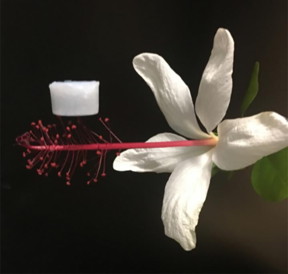Home > Press > Super-light, super-insulating ceramic aerogel keeps the hottest temperatures at bay
 |
| An optical image showing an hBNAG sample resting on the stamen of a flower. CREDIT X. Xu and X. Duan |
Abstract:
Researchers have developed a near weightless material, comprised mostly of air, capable of both withstanding and protecting against some of the most extreme temperatures experienced in aerospace and industrial environments. It performed well when heated to 900 °Celsius (C) and then rapidly cooled to -198 °C, the authors say.
Super-light, super-insulating ceramic aerogel keeps the hottest temperatures at bay
Washington, DC | Posted on February 17th, 2019Their new ceramic aerogel is engineered with unusual double-negative-index properties and demonstrates exceptional structural stability and superinsulation, making it an ideal material to be used in demanding applications like the heat shields on space vehicles. Aerogels are a composite material made mostly of air encompassed within a network of a solid medium, such as ceramic, metal, or carbon. Ceramic aerogels are incredibly lightweight and possess traits highly desired for enduring demanding environments. However, most conventional ceramic aerogels are brittle and susceptible to degradation due to extended high-temperature exposure or large and rapid temperature swings. According to the authors, these issues have greatly limited the use of ceramic aerogels as a super-insulating material. Xiang Xu and colleagues report on the design of a unique ceramic aerogel created using atomically thin sheets of hexagonal boron nitride (h-BN). By carefully engineering the ceramic aerogel microstructure, Xu et al. were able to achieve both a negative Poisson's ratio (a measure of a material's tendency to bulge outward when compressed) as well as a negative thermal expansion coefficient. To assess the material's mechanical and thermal capabilities, the authors ran a series of tests, including heating the aerogel to 900 °C and then rapidly cooling it -198 °C repeatedly, and at a rate of 275 °C per second. Xu et al. also evaluated the effect of long-term temperature stress by exposing the material to temperatures approaching 1500 °C in a vacuum. According to the results, the aerogel remained largely unchanged with near-zero strength loss following the rigorous trials. Manish Chhowalla and Deep Jariwala discuss the potential of the aerogel in a related Perspective.
####
For more information, please click here
Contacts:
Science Press Package Team
202-326-6440
Copyright © American Association for the Advancement of Science
If you have a comment, please Contact us.Issuers of news releases, not 7th Wave, Inc. or Nanotechnology Now, are solely responsible for the accuracy of the content.
| Related Links |
| Related News Press |
News and information
![]() Researchers develop molecular qubits that communicate at telecom frequencies October 3rd, 2025
Researchers develop molecular qubits that communicate at telecom frequencies October 3rd, 2025
![]() Next-generation quantum communication October 3rd, 2025
Next-generation quantum communication October 3rd, 2025
![]() "Nanoreactor" cage uses visible light for catalytic and ultra-selective cross-cycloadditions October 3rd, 2025
"Nanoreactor" cage uses visible light for catalytic and ultra-selective cross-cycloadditions October 3rd, 2025
Aerogels
![]() The lightest shielding material in the world: Protection against electromagnetic interference July 3rd, 2020
The lightest shielding material in the world: Protection against electromagnetic interference July 3rd, 2020
![]() Researchers reduce expensive noble metals for fuel cell reactions August 22nd, 2016
Researchers reduce expensive noble metals for fuel cell reactions August 22nd, 2016
![]() Aspen Aerogels to Present at the 28th Annual ROTH Conference March 14th, 2016
Aspen Aerogels to Present at the 28th Annual ROTH Conference March 14th, 2016
Possible Futures
![]() Spinel-type sulfide semiconductors to operate the next-generation LEDs and solar cells For solar-cell absorbers and green-LED source October 3rd, 2025
Spinel-type sulfide semiconductors to operate the next-generation LEDs and solar cells For solar-cell absorbers and green-LED source October 3rd, 2025
Materials/Metamaterials/Magnetoresistance
![]() First real-time observation of two-dimensional melting process: Researchers at Mainz University unveil new insights into magnetic vortex structures August 8th, 2025
First real-time observation of two-dimensional melting process: Researchers at Mainz University unveil new insights into magnetic vortex structures August 8th, 2025
![]() Researchers unveil a groundbreaking clay-based solution to capture carbon dioxide and combat climate change June 6th, 2025
Researchers unveil a groundbreaking clay-based solution to capture carbon dioxide and combat climate change June 6th, 2025
![]() A 1960s idea inspires NBI researchers to study hitherto inaccessible quantum states June 6th, 2025
A 1960s idea inspires NBI researchers to study hitherto inaccessible quantum states June 6th, 2025
![]() Institute for Nanoscience hosts annual proposal planning meeting May 16th, 2025
Institute for Nanoscience hosts annual proposal planning meeting May 16th, 2025
Announcements
![]() Rice membrane extracts lithium from brines with greater speed, less waste October 3rd, 2025
Rice membrane extracts lithium from brines with greater speed, less waste October 3rd, 2025
![]() Researchers develop molecular qubits that communicate at telecom frequencies October 3rd, 2025
Researchers develop molecular qubits that communicate at telecom frequencies October 3rd, 2025
![]() Next-generation quantum communication October 3rd, 2025
Next-generation quantum communication October 3rd, 2025
![]() "Nanoreactor" cage uses visible light for catalytic and ultra-selective cross-cycloadditions October 3rd, 2025
"Nanoreactor" cage uses visible light for catalytic and ultra-selective cross-cycloadditions October 3rd, 2025
Interviews/Book Reviews/Essays/Reports/Podcasts/Journals/White papers/Posters
![]() Spinel-type sulfide semiconductors to operate the next-generation LEDs and solar cells For solar-cell absorbers and green-LED source October 3rd, 2025
Spinel-type sulfide semiconductors to operate the next-generation LEDs and solar cells For solar-cell absorbers and green-LED source October 3rd, 2025
![]() Rice membrane extracts lithium from brines with greater speed, less waste October 3rd, 2025
Rice membrane extracts lithium from brines with greater speed, less waste October 3rd, 2025
|
|
||
|
|
||
| The latest news from around the world, FREE | ||
|
|
||
|
|
||
| Premium Products | ||
|
|
||
|
Only the news you want to read!
Learn More |
||
|
|
||
|
Full-service, expert consulting
Learn More |
||
|
|
||








